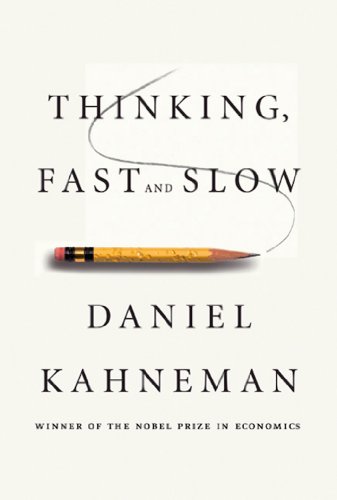

This article is an excerpt from the Shortform summary of "Thinking, Fast and Slow" by Daniel Kahneman. Shortform has the world's best summaries of books you should be reading.
Like this article? Sign up for a free trial here .
What is “fast thinking?” When should you use it, and when should you slow down?
Fast thinking is thinking that is automatic and quick. It uses little or no effort, and no sense of voluntary control.
Learn when to trust your fast thinking and why formulas usually beat intuitions.
Fast Thinking and Slow Thinking
In Thinking, Fast and Slow, Kahneman defines two systems of the mind:
System 1 (fast thinking): operates automatically and quickly, with little or no effort, and no sense of voluntary control
- Fast Thinking Examples: Detect that one object is farther than another; detect sadness in a voice; read words on billboards; understand simple sentences; drive a car on an empty road.
System 2 (slow thinking): allocates attention to the effortful mental activities that demand it, including complex computations. Often associated with the subjective experience of agency, choice and concentration
- Slow Thinking Examples: Focus attention on a particular person in a crowd; exercise faster than is normal for you; monitor your behavior in a social situation; park in a narrow space; multiple 17 x 24.
Fast Thinking is Associative
Think of your brain as a vast network of ideas connected to each other. These ideas can be concrete or abstract. The ideas can involve memories, emotions, and physical sensations.
When one node in the network is activated, say by seeing a word or image, it automatically activates its surrounding nodes, rippling outward like a pebble thrown in water.
As a fast-thinking example, consider the following two words:
“Bananas Vomit”
Suddenly, within a second, reading those two words may have triggered a host of different ideas. You might have pictured yellow fruits; felt a physiological aversion in the pit of your stomach; remembered the last time you vomited; thought about other diseases – all done automatically without your conscious control.
The evocations can be self-reinforcing – a word evokes memories, which evoke emotions, which evoke facial expressions, which evoke other reactions, and which reinforce other ideas.
Links between ideas consist of several forms:
- Cause → Effect
- Belonging to the Same Category (lemon → fruit)
- Things to their properties (lemon → yellow, sour)
Fast Thinking: Association is Fast and Subconscious
In the next exercise, you’ll be shown three words. Think of a new word that fits with each of the three words in a phrase.
Here are the three words:
cottage Swiss cake
Ready?
A common answer is “cheese.” Cottage cheese, Swiss cheese, and cheesecake. You might have thought of this quickly, without really needing to engage your brain deeply.
The next exercise is a little different. You’ll be given two sets of three words. Within seconds, decide which one feels better, without defining the new word:
sleep mail switch
salt deep foam
Ready?
You might have found that the second one felt better. Isn’t that odd? There is a very faint signal from the associative machine of fast thinking that says “these three words seem to connect better than the other three.” This occurred long before you consciously found the word (which is sea).
The Downside of Fast Thinking: Formulas Beat Intuitions
Humans have to make decisions from complicated datasets frequently. Doctors make diagnoses, social workers decide if foster parents are good, bank lenders measure business risk, and employers have to hire employees.
Unfortunately, humans are also surprisingly bad at making the right prediction. Fast thinking doesn’t always work. Universally in all studies, algorithms have beaten or matched humans in making accurate predictions. And even when algorithms match human performance, they still win because algorithms are so much cheaper.
Why are humans so bad at fast thinking? Simply put, humans overcomplicate things.
- They inappropriately weigh factors that are not predictive of performance (like whether they like the person in an interview).
- They try too hard to be clever, considering complex combinations of features when simply weighted features are sufficient.
- Their judgment varies moment to moment without them realizing it. Fast thinking is very susceptible to influences without the conscious mind realizing. The person’s environment, current mood, state of hunger, and recent exposure to information can all influence decisions. Algorithms don’t feel hunger.
- As an example, radiologists who read the same X-ray twice give different answers 20% of the time.
- Even when given data from the formula, humans are bad! They feel falsely they can “override” the formula because they see something that’s not accounted for.
An Alternative to Fast Thinking
Simple algorithms are surprisingly good predictors. Even formulas that put equal weighting on its factors can be as accurate as multiple-regression formulas, since they avoid accidents of sampling. Here are a few examples of simple algorithms that predict surprisingly accurately:
- How do you predict marital stability? Take the frequency of sex and subtract the frequency of arguments.
- How do you predict whether newborns are unhealthy and need intervention? A while back, doctors used their (poor) judgment. Instead, in 1952 doctor Virginia Apgar invented the Apgar score, a simple algorithm that takes into account 5 factors, such as skin color and pulse rate. This is still in use today.
- How do you predict wine prices for a bottle of wine? Traditionally, wine enthusiasts tasted the bottle, then assigned a hypothetical price. Instead, an economist used only two variables—the summer temperature and rainfall of the vintage. This was more accurate than humans, but wine experts were aghast—“how can you price the wine without tasting it?!” The formula was in fact better because it did not factor in human taste.
There is still some stigma about life being pervaded by robotic algorithms, removing some of the romance of life. We’d rather engage in fast thinking and rely on our intuitions.
- Professionals who use intuition to predict things feel outrage when algorithms encroach on their profession. They feel many of their predictions do turn out correct and that they have skill, but their downfall is they don’t know the boundaries of their skill.
- It seems more heart-wrenching to lose a child due to an algorithm’s mistake than because of a human error.
But this stigma against algorithms is dissipating as they recommend us useful things to buy and form winning baseball teams.
Antidote to Intuitions and Fast Thinking
When hiring for a job, Kahneman recommends standardizing the interview:
- Make a list of up to 6 traits important for success in the role. Ideally these are orthogonal traits that don’t overlap strongly with each other.
- Create direct questions to assess each trait. Use as little discretion as possible.
- If assessing conscientiousness, you might ask, “how many times were you late to work in the past month?”
- Create a rubric from 1 to 5, with notes on what you’re looking for in each grade.
- When interviewing, collect information on one trait at a time, completing it before moving on.
- Finally, hire the person with the highest score, period. Do not override this rule to favor someone else your intuition likes better—you’re letting the halo effect and liking bias override you.
When Can You Trust Human Intuition and Fast Thinking?
Clearly plenty of people develop skilled intuitions and fast-thinking abilities. Chess players do spot meaningful moves; doctors do make correct diagnoses. Within academia, the movement of Naturalistic Decision Making (NDM) puts faith in human intuition.
When can you trust human intuition? Kahneman argues accurate human intuition is developed in situations with two requirements:
- An environment that is sufficiently regular to be predictable, with fast feedback
- Prolonged practice to learn these regularities
Here are a few examples:
- Most people can learn to drive. The input → output relationship is clear and immediate.
- Doctors can learn to diagnose with limited data because they receive fast feedback on the true diagnosis from more testing.
Training can even occur theoretically, through words or thoughts. You can simulate situations and rehearse them in your brain to learn. For example, a young military commander can feel tension when going through a ravine for a first time, because he learned that this scenario invited an ambush from enemies.
To the NDM camp, Kahneman concedes that in situations with clear signals, formulas do not identify new critical factors that humans miss. Humans are efficient learners and generally don’t miss obvious predictors. However, algorithms do win at detecting signals within noisy environments.
In the brain, how do accurate intuitive decisions arise? They first arise from pattern matching in memory — your fast-thinking system retrieves a solution that fits the situation. System 2 then analyzes it, modifying it to overcome shortcomings until it seems appropriate. If the solution fails, another solution is retrieved and the process restarts.
When Not to Trust Fast Thinking
Not all supposed experts have real predictive skill. The problem with pundits and stock pickers is that they don’t train in predictable environments. When noise dominates the outcomes and feedback cycles are long, any confidence in the intuition’s validity is largely illusory.
Even worse, there can be “wicked” environments, where you learn the wrong lessons from experience if you influence the outcome. For example, doctor Lewis Thomas felt he could predict typhoid by touching the patient’s tongue. In reality, he carried typhoid on his hands—he was actually causing typhoid by touching the patient’s tongue.
Another sign of untrustworthy fast thinking is high confidence without good explanation. True experts know the limits of their knowledge and are willing to admit it. In contrast, people who are firmly confident all the time, like pundits on TV, may be hired more for their boisterousness than their accuracy.
How confident you feel about your fast thinking is not a reliable guide to its validity. You need to learn to identify situations in which intuition will betray you.
For example, you might conflate short-term results with long-term results. A psychiatrist may feel skilled in building short-term rapport with patients and believe she’s doing a great job; but short-term rapport might not correlate strongly with long-term outcomes, which take in many more factors.
———End of Preview———

Like what you just read? Read the rest of the world's best summary of "Thinking, Fast and Slow" at Shortform . Learn the book's critical concepts in 20 minutes or less .
Here's what you'll find in our full Thinking, Fast and Slow summary :
- Why we get easily fooled when we're stressed and preoccupied
- Why we tend to overestimate the likelihood of good things happening (like the lottery)
- How to protect yourself from making bad decisions and from scam artists






